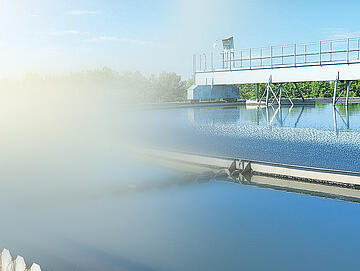
Wastewater Analysis for Chemical Parameter
- Municipal sewage plant monitoring
- Testing of legal limits in industrial process effluents
- Control of landfill leachates
We help you to generate fast measurement results in accordance with environmental laws. Make lab work more efficient despite the complexity of analytical tasks in relation to wastewater samples with particulate content.
Increase your analysis quality
- Excellent particle handling (TOC and AOX)
- Special hard- and software for turbid samples (UV/Vis)
- Correct quantification of elements with high matrix tolerance
Accelerate your process
- Ready for use equipment (TOC and AOX)
- Fast instrument setup changes to fulfill different application needs
- Highest degree of sampling automation
- Direct safety monitoring (Self Check System)
- High matrix tolerance faciliates analysis of challenging samples
- Comprehensive service and support
Analyze with us
- Total organic carbon and total bound nitrogen TOC analysis
- Adsorbable organic halogens, total halogens, and extractable organic halogens AOX analysis
- Toxic elements, e.g., chromium, cadmium, mercury, lead AAS, ICP-OES, ICP-MS
- SAC value, turbidity, ammonium, phosphate, nitrate, and chemical oxigen demand UV/Vis spectroscopy
Our analysis solutions for municipal wastewater, industrial effluents, or landfill leachates significantly reduce the effort needed for sample preparation and particle handling, while shortening measuring times for complex samples. With compliant measuring methods and robust analytical equipment, we help you to adhere to legal standards.
Exclusive e-book: Water and wastewater analysis
Our exclusive e-book offers a comprehensive overview of methods and solutions for water and wasterwater monitoring - from UV/Vis spectroscopy, sum parameter analysis to elemental analysis and microbiological testing.
Sum parameter analysis TOC, TN, and AOX in wastewater
The sum parameters total organic carbon (TOC) and total bound nitrogen (TNb) have to be measured routinely at the influent and effluent of a sewage treatment plant, both to operate the plant in the best possible manner and to meet legal limits. A sub-fraction of TOC belongs to a more toxic and persistent substance class of the halogenated hydrocarbons, which can be determined by the sum parameter AOX (adsorbable organically bound
halogens).
EU wastewater monitoring – TOC a key parameter
As a result of the implementation of the EU Industrial Emissions Directive (IED), the TOC parameter, in particular, is being introduced broadly into the monitoring of wastewater in various industries. Read this article to learn which industries are affected and how you can prepare for the new requirements.
Applications sum parameter analysis
TOC Determination in Brine Samples Coming from Desalting Process of Crude Oil
Application Note
Open PDFDetermination of Adsorbable Organic Halogens in Highly Saline Water Samples after Solid Phase Extraction (SPE-AOX)
Application Note
Open PDFTOC Monitoring in Boiler Feed and Cooling Water of Fossil-Fuel-Fired and Nuclear Power Plants
Application Note
Open PDFDetermination of AOX in Wastewater Samples by Column Method According to DIN EN ISO 9562
Application Note
Open PDFTOC Recovery in Particle-Containing Samples with the Cellulose Test According to DIN EN 1484
Application Note
Open PDFLinearitätstest für die AOX-Bestimmung nach DIN EN ISO 9562 (Säulenmethode)
Application Note
Open PDFTOC-/TNb-Bestimmung in Prozessabwässern der Papier- und Zellstoffindustrie
Application Note
Open PDFBestimmung des AOX in Abwasserproben mittels Säulenmethode gemäß DIN EN ISO 9562
Application Note
Open PDFTOC-Wiederfindung in partikelhaltigen Proben mit dem Cellulose-Test nach DIN EN 1484
Application Note
Open PDFElemental analysis AAS, ICP-MS, and ICP-OES
The analysis of toxic and ecotoxic elements is an important topic in environmental monitoring. All over the world defined regulations exist for analytical methods for the quantitative detection of lowest element concentrations. Special challenges for environmental monitoring laboratories are high sample throughput and the increasing complexity of the parameters to be monitored, as well as the increasing demands on the detection limits, all this at lowest costs.
Reliable detection of heavy metals in industrial wastewater and sludges
Heavy metals such as lead (Pb), cadmium (Cd) or nickel (Ni) are often released into the environment through industrial effluents and sludges. Some of these metals are toxic and can pollute soils and natural waters ecologically. Control of these effluents and sludges is therefore essential. Here you can find out which reliable analytical methods exist and how you can safely detect heavy metals in industrial wastewater and sludge.
Applications elemental analysis
Determination of Hg in Environmental Waters Using the PlasmaQuant MS Elite (English)
Application Note
Open PDFDetermination of Extractable Organically Bound Fluorine (EOF) in Surface Water
Application Note
Open PDFFast-sequential Analysis of Toxic Elements in Wastewater and Sewage Sludge by HR-CS AAS
Application Note
Open PDFSchnell-sequentielle Analyse giftiger Elemente in Abwasser und Klärschlamm mit der HR-CS AAS
Application Note
Open PDFUV/Vis spectroscopy Double-beam UV/Vis photometry
Many parameters in wastewater, which have to be monitored regularly, such as ammonia, nitrate, nitrite, phosphate, turbidity, SAC, COD, and BOD can be analyzed with UV/Vis spectrophotometers. Herewith not only qualitative and quantitative analyses of the parameters are possible, but also substance-specific information can be obtained. The measurement results by means of UV/Vis spectrometry are quickly available, reliable, and cost-effective. They are suitable for optimization and control of processes in wastewater treatment plants and for checking the reference and limit values.
Applications UV/vis spectroscopy
Determination of Concentration by Means of a Calibration Curve – Exemplified by Surfactant Measurements According to PD CLC/TS 50677:2019
Application Note
Open PDFSpectrophotometric Determination of Standard Parameters in Wastewater According to Standard Methods
Application Note
Open PDFBestimmung der Konzentration mithilfe einer Kalibrierkurve – am Beispiel von Tensid- Messungen nach PD CLC/TS 50677:2019
Application Note
Open PDFSpektrophotometrische Bestimmung von Standardparametern in Abwasser nach Normverfahren
Application Note
Open PDFContact
The newsletter of Analytik Jena frequently keeps you posted about:
- News
- Trends and developments
- Events
